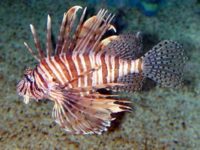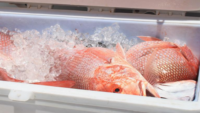Funky Fish: Is Ciguatera Fish Poisoning on the Rise?

Ciguatera fish poisoning is a foodborne illness resulting from the consumption of contaminated tropical and subtropical saltwater fish, particularly those from coral reefs. Implicated fish are generally large, carnivorous species such as barracuda, grouper, amberjack and snapper. Illness can be severe, with acute gastrointestinal symptoms as well as neurologic issues (paresthesias, weakness, pain, temperature reversal, memory/concentration problems, among others) that can persist for months or longer.[1] Ciguatoxins are the cause of illness, and they originate from Gambierdiscus species dinoflagellates (microalgae) as precursor toxins called gambiertoxins. As these toxins move up trophic levels to larger fish, they are biotransformed and become the potent poison that causes an estimated 50,000–500,000 illnesses per year worldwide.[2,3]
Because algae growth is impacted by temperature, it is believed that the incidence and geographical range of ciguatera and other harmful algal blooms will be affected by climate change. Growth rates for Gambierdiscus species dinoflagellates are highest in warm temperatures (optimum 29–30 °C), and thus with warming waters, it is possible that we will start to see them move into areas that have historically been too cold. Some studies have observed positive associations between seawater temperature and ciguatera incidence,[4–9] but more evidence is needed to show whether this relationship will actually result in increased incidence. It can be difficult to obtain complete epidemiologic information on ciguatera, particularly looking at long-term trends, as the existence and quality of surveillance programs vary widely between areas and over time. Even when surveillance programs are operational, underreporting is a significant issue. The rest of this article will review recent studies on this issue in the U.S. Virgin Islands and in Florida.
Research in the U.S. Virgin Islands
As with many island communities in the Caribbean and South Pacific, ciguatera is endemic in St. Thomas. “Fish poisoning” is a well-known health concern among islanders and fishermen. A multidisciplinary research group from several institutions selected this location to dig deeper into the factors influencing ciguatera and to better understand each step of the pathway from algae to human illness. The team (Project CaribCATCH) included clinical and epidemiologic studies (University of Maryland, Baltimore; University of Florida), environmental studies (University of the Virgin Islands; Woods Hole Oceanographic Institution), climate studies (Florida State University) and toxin studies (U.S. Food and Drug Administration). While much of the work is still underway, some results are already available.
Incidence
Two islandwide random-digit-dial telephone surveys were performed in 2010 and 2011. They included questions on demographics, fish consumption, history of ciguatera episodes in the participant and their household, and ciguatera awareness. A medical record review of emergency department visits was performed for 1995–2011 (2000–2001 and 2006 were missing) to determine the number of visits for ciguatera.[10] These results were compared with similar data from St. Thomas in 1980.[11]
Eight hundred seven residents participated in the telephone surveys (response rate 25%). Of the participants, 186 (23%) reported that they had ever had ciguatera, and there were 339 total episodes reported. The average annual incidence was estimated as 12 per 1,000 (95% CI 10–21) from the survey. In the 1980 survey, the incidence among adults was approximately 14 per 1,000, so no increase was observed, counter to expectations. Similar results were observed in the emergency department data. In exploring reasons for this lack of increase, it was observed that frequency of fish consumption, socioeconomic status and age distribution had changed on the island over this period. Since illness was associated with lower education levels (OR 0.3, 95% CI 0.2–0.5 for some college or more; OR 0.5, 95% CI 0.3–0.8 for high school graduate vs. some high school or less), higher levels of fish consumption (OR 2.2, 95% CI 1.4–3.5 for eating fish at least three times a week vs. fewer than three times a week) and having previous episodes of ciguatera (OR 4.2, 95% CI 1.9–9.5), population shifts from 1980 to 2010 in these factors could have helped compensate for rising seawater temperatures.10 More research is needed to identify and characterize the factors associated with ciguatera in this region.
Other Research in St. Thomas
There are several other important projects still being analyzed from this research effort. Clinical studies include a longitudinal analysis of diagnosed cases of ciguatera on the island, with visits at 0, 3 and 12 months after onset to better characterize the illness and quantify rates of chronicity. Thus far, 62 cases have been followed, with 56 percent having dermal and neurologic symptoms 3 months after onset and 13 percent continuing to have vague neurologic complaints after 1 year.[12] Environmental studies include extensive monitoring of four sites around the island. Data include environmental parameters (seawater temperature, salinity, precipitation, wind speed), Gambierdiscus populations, coral species composition/health, macroalgal cover/composition, nutrients and the toxicity of dinoflagellate field samples and fish. Toxin studies include working to optimize detection of toxin in fish and developing methods for diagnosing disease in patients. Climate studies include correlating weather patterns, particularly the Atlantic Warm Pool, with Gambierdiscus population and disease incidence data.
Research in Florida
While St. Thomas is well within the typical geographic range for ciguatera, Florida represents a different opportunity for research. The state lies on the edge of the geographic range—ciguatera is reported fairly commonly in South Florida, but is much less common farther north. This makes it a useful location for observing the impact of climate change, as northern movement would be expected. In addition, there is already public health surveillance in place, which is useful for measuring trends over time. However, underreporting is substantial and unquantified, and historical data for comparison are limited. An analysis of reports to the Florida Department of Health (FDOH) from 2000 to 2011 was combined with a survey of recreational fishermen to estimate incidence by adjusting for underreporting, evaluate catch locations for illness-causing fish and identify high-risk demographic groups and fish types.[13]
Floridians are not as familiar with ciguatera as U.S. Virgin Islanders are. Members of the general public are likely to have not heard of it at all, while fishermen in South Florida may have some limited knowledge. Because of this, a survey of the general population was not considered a good approach for estimating incidence. Instead, recreational saltwater fishing license holders were surveyed by email. Home addresses were obtained for all 2011 licensees from the Florida Fish and Wildlife Conservation Commission, and the survey was sent to all who provided an email address (311,799; approximately 10% were undeliverable). There were 5,352 participants. They were asked whether they had ever received a diagnosis of ciguatera (likely cases) or experienced a list of symptoms after eating saltwater fish (possible cases), as well as the type of fish, where they caught it and medical attention sought.
Reports to FDOH served as the base incidence rate. Annual incidence averaged 0.2 per 100,00 statewide, 1 per 100,000 in Miami-Dade County and 3 per 100,000 in Monroe County (Florida Keys). Survey data were used to estimate underreporting and adjust those rates. Three types of underreporting were considered: (1) affected persons who do not seek medical attention for their illness [in the survey, 57% (95% CI 52–63) of likely and possible cases sought medical attention for their illness]; (2) persons who seek medical attention but whose illness is not appropriately diagnosed [most cases in the survey (88%, 95% CI 19–40) were diagnosed (i.e., were likely vs. possible)]; and (3) persons who received a diagnosis that was not reported to FDOH. Cases who stated they received a diagnosis in Florida and were willing to provide identifiers were matched to FDOH records. Only 7 percent (95% CI 0–18) were reported to FDOH. Based on these levels of underreporting, incidence estimates were increased by a factor of 28, to 5.6 per 100,000 statewide, 28 per 100,000 in Miami-Dade County and 84 per 100,000 in Monroe County. A comparable historical rate was not available except for in Miami. Before adjusting for underreporting, an estimate in 1980 was 5 per 100,000[14] compared with 1 per 100,000 in this study.
Fishers reported catching the majority of implicated fish in the Bahamas (34%) and Florida Keys (20%). Cuba and Palm Beach County were the next most common, each with 5 percent, followed by Miami-Dade County with 4 percent. Toxic fish were only sporadically caught north of Palm Beach. This was consistent with data from 1954 to 1992, although that study did not include fish caught outside Florida.[15] There was a higher percentage of implicated fish north of South Florida in the cases identified through the email survey than in the FDOH reports. This could indicate a bias in reporting due to better physician awareness in South Florida, or it could be a result of illnesses unrelated to ciguatera. Overall, there was little evidence that the geographic range or incidence had increased over time. However, these data provide a solid baseline for future comparisons, and this area should be monitored closely in the future.
 In looking at demographics, Hispanic ethnicity was an important risk factor. Hispanics had a relative risk of 3.4 compared with non-Hispanics. Fish consumption may play a role in that difference. Illness among Hispanics was more likely than in non-Hispanics to have been caused by barracuda (Table 1[13]).
In looking at demographics, Hispanic ethnicity was an important risk factor. Hispanics had a relative risk of 3.4 compared with non-Hispanics. Fish consumption may play a role in that difference. Illness among Hispanics was more likely than in non-Hispanics to have been caused by barracuda (Table 1[13]).
The types of fish consumed by all cases were consistent with past research. Grouper was most commonly reported (31%), followed by barracuda (18%), amberjack (8%), snapper (8%) and hogfish (7%). However, after adjusting for total commercial and recreational landings as a proxy for consumption, hogfish and barracuda looked to be particularly high risk.[13]
Conclusions
While the studies in the U.S. Virgin Islands and in Florida did not find evidence of an increase in incidence or geographic range of ciguatera over time, past research has shown strong evidence of a relationship between seawater temperature and growth of the toxin-producing algae. There are many reasons why it may not have been observed in these studies. Some possibilities: changing demographics and risk behaviors (fish consumption), increased awareness of risk, differences in current data versus historical data, other environmental influences (including coral reef health), changes in Gambierdiscus or the toxin or changes in fish populations. It is also possible that more time is needed for the increase to become measurable. In any case, as our seawaters continue to warm as a result of climate change, it is critical to continue research on this issue.
While ciguatera continues to be a public health concern, the best way to prevent illnesses is to increase awareness in at-risk populations. There is no accurate way to detect the toxin in fish without extensive laboratory testing, and it cannot be cooked or frozen out of the meat. So it is important for public health and food safety authorities to educate the public on high-risk fish species. Many of the fish species (e.g., grouper, snapper) implicated are very commonly eaten without issue and thus do not need to be avoided altogether (though eating smaller fish will reduce risk). Others such as barracuda are high-enough risk that messaging should recommend complete avoidance. For all of these fish, it is useful for people to be aware of the risk so that they can take action if they become ill—seek medical attention, let their provider know that they ate saltwater fish and, if possible, keep some of the fish in the freezer for confirmatory testing.
Among the outstanding researchers contributing to Project CaribCATCH: J. Glenn Morris Jr. (principal investigator, University of Florida Emerging Pathogens Institute), Lynn Grattan and Sparkle Roberts (University of Maryland, Baltimore), Tyler Smith (University of the Virgin Islands), Don Anderson and Mindy Richlen (Woods Hole Oceanographic Institution), Alison Robertson (U.S. Food and Drug Administration) and Vasu Misra (Florida State University). I was an epidemiology doctoral student working on this project. My Florida study collaborators were J. Glenn Morris Jr. and Andrew Reich.
Elizabeth G. Radke, Ph.D., M.P.H., is the communicable disease epidemiologist for the Arlington County (VA) Public Health Division. She previously worked as the Arbovirus Surveillance Coordinator for the Florida Department of Health. She received a Ph.D. in epidemiology from the University of Florida and an M.P.H. in epidemiology from the University of Pittsburgh.
References
1. Friedman, MA, et al. 2008. Ciguatera fish poisoning: Treatment, prevention and management. Mar Drugs 6:456–479.
2. Fleming, LE, et al. 1998. “Marine seafood toxin diseases: Issues in epidemiology and community outreach,” in Harmful Algae, eds. B Reguera, J Blanco, ML Fernandez and T Wyatt (Galicia: Xunta de Galicia and Intergovernmental Commission of UNESCO), 245–248.
3. Dickey, RW and SM Plakas. 2010. Ciguatera: A public health perspective. Toxicon 56:123–136.
4. Hales, S, et al. 1999. Ciguatera (fish poisoning), el Nino, and Pacific sea surface temperatures. Ecosystem Health 5:20–25.
5. Chateau-Degat, ML, et al. 2005. Seawater temperature, Gambierdiscus spp. variability and incidence of ciguatera poisoning in French Polynesia. Harmful Algae 4:1053–1062.
6. Llewellyn, LE. 2010. Revisiting the association between sea surface temperature and the epidemiology of fish poisoning in the south Pacific: Reassessing the link between ciguatera and climate change. Toxicon 56:691–697.
7. Tester, PA, et al. 2010. Ciguatera fish poisoning and sea surface temperatures in the Caribbean Sea and the West Indies. Toxicon 56:698–710.
8. Skinner, MP, et al. 2011. Ciguatera fish poisoning in the Pacific islands (1998 to 2008). PLoS Negl Trop Dis 5:e1416.
9. Gingold, DB, et al. 2014. Ciguatera fish poisoning and climate change: Analysis of national poison center data in the United States, 2001–2011. Environ Health Perspect 122:580–586.
10. Radke, EG, et al. 2013. Ciguatera incidence in the US Virgin Islands has not increased over a 30-year time period despite rising seawater temperatures. Am J Trop Med Hyg 88:908–913.
11. Morris, JG, et al. 1982. Ciguatera fish poisoning epidemiology of the disease on St. Thomas, U.S. Virgin Islands. Am J Trop Med Hyg 31:574–578.
12. Grattan, LG, et al. 2013. “Ciguatera fish poisoning in St. Thomas, USVI: Exposure, symptoms, and recovery,” (Proceedings: 7th Symposium on Harmful Algal Blooms in the U.S.), 45.
13. Radke, EG, et al. 2015. Epidemiology of ciguatera in Florida. Am J Trop Med Hyg 93:425–432.
14. Lawrence, DN, et al. 1980. Ciguatera fish poisoning in Miami. JAMA 244:254–258.
15. Desylva, DP. 1994. Distribution and ecology of ciguatera fish poisoning in Florida, with emphasis on the Florida-Keys. Bull Mar Sci 54:944–954.
Looking for a reprint of this article?
From high-res PDFs to custom plaques, order your copy today!









